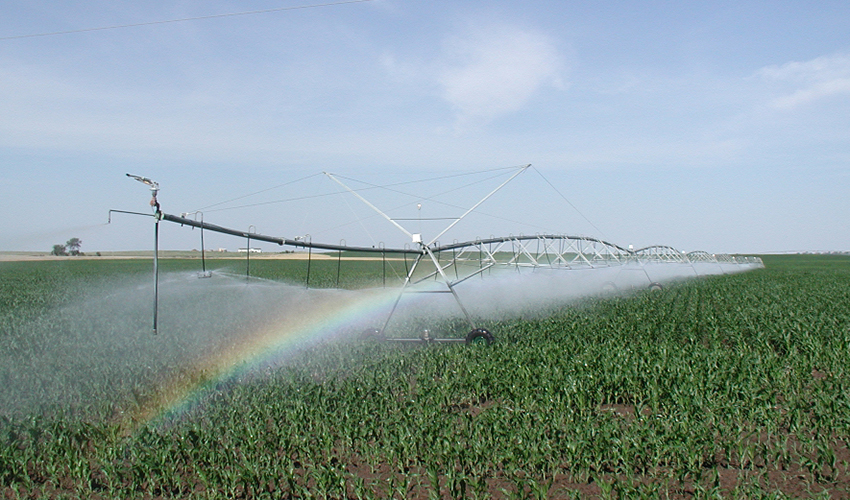Hydrologist leads global call for action on groundwater management

Groundwater from the High Plains aquifer is used to irrigate a cornfield. A group of scientists including SF State Associate Professor of Earth & Climate Sciences Jason Gurdak is urging world leaders to develop a plan to manage and preserve groundwater, a critically important source of irrigation water for global food production. Photo: Jason Gurdak
A team of scientists led by a San Francisco State University hydrologist is calling on global leaders to work together to develop strategies for maintaining the world's crucial groundwater supplies amid escalating climate change and human development.
Groundwater is the primary source of drinking water for more than half of the world's population, according to a report issued today from the United Nations' Groundwater Resources Assessment under the Pressures of Humanity and Climate Change (GRAPHIC) project. But a rapid increase in groundwater extraction largely to support irrigated agricultural over the last five decades indicates a dire need for careful planning and cooperation among world leaders to avoid depleting this crucial resource, the authors write.

Associate Professor of Earth & Climate Sciences Jason Gurdak
The report will be presented Tuesday in Paris during the Conference of the Parties to the United Nations Framework Convention on Climate Change (COP21).
"Groundwater provides a big benefit to many regions of the world, but it needs to be carefully managed," said Jason Gurdak, an associate professor of earth and climate sciences at SF State and coordinator of the GRAPHIC project. "There are still large regions of the globe where there is no discussion of groundwater resources and no legislation or regulation for how they are managed."
In the report, the authors call sustainable groundwater an issue of national and international security and urge world leaders to partner with stakeholders at all levels to improve groundwater governance and create sustainable management practices.
Because it is less susceptible to the effects of climate change than surface water, groundwater is a critical buffer in the water supply that can help mitigate the impacts of climate change, said Gurdak, who has written extensively about the effects of climate change on groundwater supplies. However, it is also a resource that is, for all practical human purposes, finite.
"Much of the groundwater in our largest, most important aquifers was recharged thousands and tens of thousands of years ago," he said. "They're not being recharged on timescales that are similar to human activity. Once we use these large aquifers, that's it."
Gurdak points to several regions of the world -- including California's Central Valley, the U.S. High Plains and parts of China and India -- where the lack of regulations has led to dramatic drops in groundwater levels. But he says recent legislation in California mandating the creation of groundwater management plans is encouraging -- and an example of the type of action that can occur when leaders at all levels work together on this issue.
"There has to be a commitment from political leaders to create adequate, sustainable governance of our groundwater resources, but it's not a top-down approach," he said. "We need stakeholders at the local level, because groundwater is best managed locally. That's really the new framework we're seeing in California."
In many instances, especially in the developing world, authorities either do not measure or do not have the resources to measure how much water is in an aquifer, how much is being pumped out or how much is being recharged, Gurdak said.
"The type of action we need comes about by leadership at the state and federal level," he said. "The world's attention will be on these climate change discussions, so it's a really important time to bring up these issues about water and groundwater specifically."
GRAPHIC is a project of the United Nations Educational, Scientific and Cultural Organization (UNESCO). The report, "Groundwater and Climate Change: Mitigating the Global Groundwater Crisis and Adapting to Climate Change," can be read online at http://www.graphicnetwork.net/wp-content/uploads/2015/11/GRAPHIC_pp20151.pdf.